|
 In Association With
Mysteries
Magazine!
In Association With
Mysteries
Magazine!
10/26/07 #440
http://www.conspiracyjournal.com
Subscribe for free at our subscription page:
http://www.members.tripod.com/uforeview/subscribe.html
You can view this newsletter online at:
https://uforeview.tripod.com/conspiracyjournal440.html
This week Conspiracy Journal
brings you such trick-or-treating stories as:
- Dragonfly or Insect Spy? Scientists at
Work on Robobugs -
-
Skinwalkers, What Are They? -
- Return to Sleepy Hollow -
-
Rock-Star
Ghost Diaries
-
AND: India's Cow Eating Trees
All these exciting stories and MORE
in this week's issue of
CONSPIRACY JOURNAL!
~ And Now, On With The Show! ~

MORE IMPORTANT THAN
THE BIBLE CODE!

Obtain Your Every Desire By Activating The
Secret Meaning of Hundreds of Bible Verses
Here are ancient magick techniques using secret power verses
taken from the Holy Scriptures to gain enlightenment, health, good
fortune and all around prosperity. These easy to perform spiritual
spells will have a deep impact on YOUR life and those of your loved
ones.
Beginning in his childhood William Oribello experienced contacts with
Divine Forces in the forms of Angelic Beings and Ascended Masters.
These spiritual contacts taught him the secrets of the CREATIVE FORCE and how we all can
utilize special POWER VERSES
from the Holy Bible, along with ordinary candles, incense, crystals and
gemstones for Luck, Love, and Well Being.
In this book you will find BIBLE
VERSE SPELLS for: Love and Romance. Money and Business Success.
Achieving Good Luck and Removing Bad Luck and curses. Protection of
your home and loved one's Health, healing and happiness. To receive
divine grace and mercy, AND MUCH,
MUCH, MORE!
This
fascinating
book is now available for the
extra-special price of only $20.00
BUT WAIT, THERE'S MORE! If you order right now, we will also
include a
FREE Audio CD by
William
Oribello
So don't delay, order your copy
of BIBLE SPELLS
today for only $20.00 plus
$5.00 for shipping -
A GREAT PRICE!
You can also phone in your
credit card orders to Global Communications
24-hour hotline: 732-602-3407
And as always you can send a
check or money order to:
Global Communications
P.O. Box 753
New Brunswick, NJ 08903
NOW ON
SALE!
MYSTERIES MAGAZINE #18

In This Fantastic Issue:
Mental Armageddon: The Quest for Mind Control
Radionics: Mind Machines for Better Health
Mark David Chapman: Lone Nut or CIA Assassin?
America and Bio-Weapons: A Troubling Ethos
The Healing Sounds of Jonathan Goldman
And so much more, including book, music, and movie reviews,
exhibit listings, your fall horoscope, and conference listings!
Get
your issue TODAY at your favorite bookstore
or magazine stand.
- BUGGED BY BUGS DEPARTMENT -
Dragonfly or Insect Spy? Scientists at Work on Robobugs
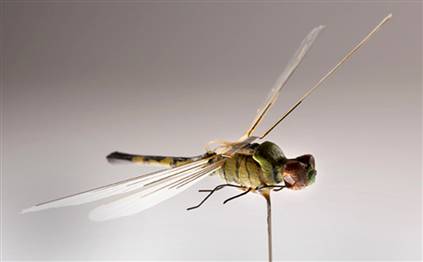
Vanessa Alarcon saw them while
working at an antiwar rally in Lafayette Square last month.
"I heard someone say, 'Oh my god, look at those,' " the college senior
from New York recalled. "I look up and I'm like, 'What the hell is
that?' They looked kind of like dragonflies or little helicopters. But
I mean, those are not insects."
Out in the crowd, Bernard Crane saw them, too.
"I'd never seen anything like it in my life," the Washington lawyer
said. "They were large for dragonflies. I thought, 'Is that mechanical,
or is that alive?' "
That is just one of the questions hovering over a handful of similar
sightings at political events in Washington and New York. Some suspect
the insectlike drones are high-tech surveillance tools, perhaps
deployed by the Department of Homeland Security.
Others think they are, well, dragonflies -- an ancient order of insects
that even biologists concede look about as robotic as a living creature
can look.
No agency admits to having deployed insect-size spy drones. But a
number of U.S. government and private entities acknowledge they are
trying. Some federally funded teams are even growing live insects with
computer chips in them, with the goal of mounting spyware on their
bodies and controlling their flight muscles remotely.
The robobugs could follow suspects, guide missiles to targets or
navigate the crannies of collapsed buildings to find survivors.
The technical challenges of creating robotic insects are daunting, and
most experts doubt that fully working models exist yet.
"If you find something, let me know," said Gary Anderson of the Defense
Department's Rapid Reaction Technology Office.
But the CIA secretly developed a simple dragonfly snooper as long ago
as the 1970s. And given recent advances, even skeptics say there is
always a chance that some agency has quietly managed to make something
operational.
"America can be pretty sneaky," said Tom Ehrhard, a retired Air Force
colonel and expert in unmanned aerial vehicles who is now at the Center
for Strategic and Budgetary Assessments, a nonprofit Washington-based
research institute.
Robotic fliers have been used by the military since World War II, but
in the past decade their numbers and level of sophistication have
increased enormously. Defense Department documents describe nearly 100
different models in use today, some as tiny as birds, and some the size
of small planes.
All told, the nation's fleet of flying robots logged more than 160,000
flight hours last year -- a more than fourfold increase since 2003. A
recent report by the U.S. Army Command and General Staff College warned
that if traffic rules are not clarified soon, the glut of unmanned
vehicles "could render military airspace chaotic and potentially
dangerous."
But getting from bird size to bug size is not a simple matter of making
everything smaller.
"You can't make a conventional robot of metal and ball bearings and
just shrink the design down," said Ronald Fearing, a roboticist at the
University of California at Berkeley. For one thing, the rules of
aerodynamics change at very tiny scales and require wings that flap in
precise ways -- a huge engineering challenge.
Only recently have scientists come to understand how insects fly -- a
biomechanical feat that, despite the evidence before scientists' eyes,
was for decades deemed "theoretically impossible." Just last month,
researchers at Cornell University published a physics paper clarifying
how dragonflies adjust the relative motions of their front and rear
wings to save energy while hovering.
That kind of finding is important to roboticists because flapping
fliers tend to be energy hogs, and batteries are heavy.
The CIA was among the earliest to tackle the problem. The
"insectothopter," developed by the agency's Office of Research and
Development 30 years ago, looked just like a dragonfly and contained a
tiny gasoline engine to make the four wings flap. It flew but was
ultimately declared a failure because it could not handle crosswinds.
Agency spokesman George Little said he could not talk about what the
CIA may have done since then. The Office of the Director of National
Intelligence, the Department of Homeland Security and the Secret
Service also declined to discuss the topic.
Only the FBI offered a declarative denial. "We don't have anything like
that," a spokesman said.
The Defense Department is trying, though.
In one approach, researchers funded by the Defense Advanced Research
Projects Agency (DARPA) are inserting computer chips into moth pupae --
the intermediate stage between a caterpillar and a flying adult -- and
hatching them into healthy "cyborg moths."
The Hybrid Insect Micro-Electro-Mechanical Systems project aims to
create literal shutterbugs -- camera-toting insects whose nerves have
grown into their internal silicon chip so that wranglers can control
their activities. DARPA researchers are also raising cyborg beetles
with power for various instruments to be generated by their muscles.
"You might recall that Gandalf the friendly wizard in the recent
classic 'Lord of the Rings' used a moth to call in air support," DARPA
program manager Amit Lal said at a symposium in August. Today, he said,
"this science fiction vision is within the realm of reality."
A DARPA spokeswoman denied a reporter's request to interview Lal or
others on the project.
The cyborg insect project has its share of doubters.
"I'll be seriously dead before that program deploys," said vice admiral
Joe Dyer, former commander of the Naval Air Systems Command, now at
iRobot in Burlington, Mass., which makes household and military robots.
By contrast, fully mechanical micro-fliers are advancing quickly.
Researchers at the California Institute of Technology have made a
"microbat ornithopter" that flies freely and fits in the palm of one's
hand. A Vanderbilt University team has made a similar device.
With their sail-like wings, neither of those would be mistaken for
insects. In July, however, a Harvard University team got a truly
fly-like robot airborne, its synthetic wings buzzing at 120 beats per
second.
"It showed that we can manufacture the articulated, high-speed
structures that you need to re-create the complex wing motions that
insects produce," said team leader Robert Wood.
The fly's vanishingly thin materials were machined with lasers, then
folded into three-dimensional form "like a micro-origami," he said.
Alternating electric fields make the wings flap. The whole thing weighs
just 65 milligrams, or a little more than the plastic head of a push
pin.
Still, it can fly only while attached to a threadlike tether that
supplies power, evidence that significant hurdles remain.
In August, at the International Symposium on Flying Insects and Robots,
held in Switzerland, Japanese researchers introduced radio-controlled
fliers with four-inch wingspans that resemble hawk moths. Those who
watch them fly, its creator wrote in the program, "feel something of
'living souls.' "
Others, taking a tip from the CIA, are making fliers that run on
chemical fuels instead of batteries. The "entomopter," in early stages
of development at the Georgia Institute of Technology and resembling a
toy plane more than a bug, converts liquid fuel into a hot gas, which
powers four flapping wings and ancillary equipment.
"You can get more energy out of a drop of gasoline than out of a
battery the size of a drop of gasoline," said team leader Robert
Michelson.
Even if the technical hurdles are overcome, insect-size fliers will
always be risky investments.
"They can get eaten by a bird, they can get caught in a spider web,"
said Fearing of Berkeley. "No matter how smart you are -- you can put a
Pentium in there -- if a bird comes at you at 30 miles per hour there's
nothing you can do about it."
Protesters might even nab one with a net -- one of many reasons why
Ehrhard, the former Air Force colonel, and other experts said they
doubted that the hovering bugs spotted in Washington were spies.
So what was seen by Crane, Alarcon and a handful of others at the D.C.
march -- and as far back as 2004, during the Republican National
Convention in New York, when one observant but perhaps paranoid
peace-march participant described on the Web "a jet-black dragonfly
hovering about 10 feet off the ground, precisely in the middle of 7th
avenue . . . watching us"?
They probably saw dragonflies, said Jerry Louton, an entomologist at
the National Museum of Natural History. Washington is home to some
large, spectacularly adorned dragonflies that "can knock your socks
off," he said.
At the same time, he added, some details do not make sense. Three
people at the D.C. event independently described a row of spheres, the
size of small berries, attached along the tails of the big dragonflies
-- an accoutrement that Louton could not explain. And all reported
seeing at least three maneuvering in unison.
"Dragonflies never fly in a pack," he said.
Mara Verheyden-Hilliard of the Partnership for Civil Justice said her
group is investigating witness reports and has filed Freedom of
Information Act requests with several federal agencies. If such devices
are being used to spy on political activists, she said, "it would be a
significant violation of people's civil rights."
For many roboticists still struggling to get off the ground, however,
that concern -- and their technology's potential role -- seems
superfluous.
"I don't want people to get paranoid, but what can I say?" Fearing
said. "Cellphone cameras are already everywhere. It's not that much
different."
Source: The Washington Post
http://www.washingtonpost.com/wp-dyn/content/article/2007/10/08/AR2007100801434.html
-
RUNNING WITH THE SUPERNATURAL DEPARTMENT -
Skinwalkers, What Are They?
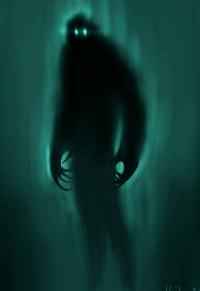
With skinwalkers becoming the subjects of popular books and recently,
movies, it is fair to ask about their origins. In August 1996, a team
of scientists arrived on a remote ranch in NE Utah to investigate a
bizarre litany of phenomena; including unidentified flying objects,
animal mutilations, paranormal and poltergeist occurrences that
appeared to erupt almost on a nightly basis. [Hunt for the Skinwalker]
The list went on and on. The first piece of information the team
learned from local people was that the ranch lay "on the path of the
skinwalker"”. Was the skinwalker responsible for the weird happenings
on this ranch? What followed was a multi-year odyssey into the dark
unknown as the science team tried to pursue, measure and photograph the
elusive "skinwalker". The complete account of the unprecedented
research project is published in the book Hunt for the Skinwalker
(Amazon US and Amazon UK).
In the religion and cultural lore of Southwestern tribes, there are
witches known as skinwalkers who can alter their shapes at will to
assume the characteristics of certain animals. Most of the world’s
cultures have their own shapeshifter legends. The best known is the
werewolf, popularized by dozens of Hollywood movies. European legends
as far back as the 1500’s tell stories about werewolves. (The modern
psychiatric term for humans who believe they are wolves is
lycanthropy.) The people of India have a were-tiger legend. Africans
have stories of were-leopards and were-jackals. Egyptians tell of
were-hyenas.
In the American Southwest, the Navajo, Hopi, Utes, and other tribes
each have their own version of the skinwalker story, but basically they
boil down to the same thing - a malevolent witch capable of
transforming itself into a wolf, coyote, bear, bird, or any other
animal. The witch might wear the hide or skin of the animal identity it
wants to assume, and when the transformation is complete, the human
witch inherits the speed, strength, or cunning of the animal whose
shape it has taken.
"The Navajo skinwalkers use mind control to make their victims do
things to hurt themselves and even end their lives," writes Doug
Hickman, a New Mexico educator. "The skinwalker is a very powerful
witch. They can run faster than a car and can jump mesa cliffs without
any effort at all."
For the Navajo and other tribes of the southwest, the tales of
skinwalkers are not mere legend. Just ask Michael Stuhff. A Nevada
attorney, Stuhff is likely one of the few lawyers in the history of
American jurisprudence to file legal papers against a Navajo witch. He
has often represented Native Americans in his practice. He understands
Indian law and has earned the trust of his Native American clients, in
large part because he knows and respects tribal religious beliefs.
As a young attorney in the mid-70s, Stuhff worked in a legal aid
program based near Genado Arizona. Many, if not most, of his clients
were Navajo. His legal confrontation with a witch occurred in a dispute
over child custody and financial support. His client, a Navajo woman
who lived on the reservation with her son, was asking for full custody
rights and back child support payments from her estranged husband, an
Apache man. At one point during the legal wrangling, the husband got
permission to take the son out for an evening, but didn't return the
boy until the next day. The son later told his mother what had
transpired that night.
According to the son, he spent the night with his father and a
"medicine man." They built a fire atop a cliff and, for many hours, the
medicine man performed ceremonies, songs, and incantations around the
fire. As dawn broke, the three traveled into a wooded area near a
cemetery, where they dug a hole. Into the hole, the medicine man
deposited two dolls made of wood. One of the dolls was made of dark
wood, the other of light wood. It was as if the two dolls were meant to
represent the mother and her lawyer. Although Stuhff wasn't sure how
seriously to take the news, he recognized that it certainly didn't
sound good, so he sought out the advice of a Navajo professor at a
nearby community college.
"He told me that the ceremony I had described was very powerful and
very serious and that it meant that I was supposed to end up buried in
that cemetery," Stuhff says. "He also said that a witch can perform
this type of ceremony only four times in his life, because if he tries
it more than that, the curse would come back on the witch himself. He
also told me that if the intended victim found out about it, then the
curse would come back onto the person who had requested it."
Stuhff thought about a way to let the husband know that he had found
out about the ceremony, so he filed court papers that requested an
injunction against the husband and the unknown medicine man, whom he
described in the court documents as "John Doe, A Witch." The motion
described in great detail the alleged ceremony. The opposing attorney
appeared extremely upset by the motion, as did the husband and the
presiding judge. The opposing lawyer argued to the court that the
medicine man had performed "a blessing way ceremony," not a curse. But
Stuhff knew that the judge, who was a Navajo, could distinguish between
a blessing ceremony, which takes place in Navajo hogans (homes), and
what was obviously a darker ceremony involving lookalike dolls that
took place in the woods near a cemetery. The judge nodded in agreement
when Stuhff responded. Before the judge could rule, Stuhff requested a
recess so that the significance of his legal motion could sink in. The
next day, the husband capitulated by agreeing to grant total custody to
the mother and to pay all back child support. "I took it very seriously
because he took it seriously," Stuhff says. "I learned early on that
sometimes witches will do things themselves to assist the supernatural,
and I knew what that might mean."
Whether or not Stuhff literally believes that witches have supernatural
powers, he acknowledges that this belief is strongly held in the Navajo
nation. Certain communities on the reservation had reputations as
witchcraft strongholds, he says. It is also unknown whether the witch
he faced was a skinwalker or not. "Not all witches are skinwalkers," he
says, "but all skinwalkers are witches. And skinwalkers are at the top.
They are a witch's witch, so to speak."
According to University of Nevada-Las Vegas anthropologist Dan
Benyshek, who specializes in the study of Native Americans of the
Southwest, "Skinwalkers are purely evil in intent. I'm no expert on it,
but the general view is that skinwalkers do all sorts of terrible
things - they make people sick, they commit murders. They are
graverobbers and necrophiliacs. They are greedy and evil people who
must kill a sibling or other relative to be initiated as a skinwalker.
They supposedly can turn into were-animals and can travel in
supernatural ways."
Benyshek and other scientists do not necessarily endorse the legitimacy
of the legends, but they recognize the importance of studying stories
about skinwalkers because the power of the belief among Native
Americans manifests itself in ways that are very real. "Oh,
absolutely," Benyshek explains. "Anthropologists have conducted
scientific investigations into the beliefs in Native American
witchcraft because of the effects of such beliefs on human health."
Anthropologist David Zimmerman of the Navajo Nation Historic
Preservation Department explains: "Skinwalkers are folks that possess
knowledge of medicine, medicine both practical (heal the sick) and
spiritual (maintain harmony), and they are both wrapped together in
ways that are nearly impossible to untangle."
As Zimmerman suggests, the flip side of the skinwalker coin is the
power of tribal medicine men. Among the Navajo, for instance, medicine
men train over a period of many years to become full-fledged
practitioners in the mystical rituals of the Dine' (Navajo) people. The
U.S. Public Health Service now works side by side with Navajo medicine
men because the results of this collaboration have been proven, time
and again, in clinical studies. The medicine men have shown themselves
to be effective in treating a range of ailments. "There has been a lot
of serious research into medicine men and traditional healers," says
Benyshek. "As healers, they are regarded as being very effective in
some areas."
But there is a dark side to the learning of the medicine men. Witches
follow some of the same training and obtain similar knowledge as their
more benevolent colleagues, but they supplement both with their pursuit
of the dark arts, or black magic. By Navajo law, a known witch has
forfeited its status as a human and can be killed at will. The
assumption is that a witch, by definition, is evil.
"Witchcraft was always an accepted, if not widely acknowledged part of
Navajo culture," wrote journalist A. Lynn Allison. "And the killing of
witches was historically as much accepted among the Navajo as among the
Europeans." Allison has studied what she calls the "Navajo Witch Purge
of 1878" and has written a book on the subject. In that year, more than
40 Navajo witches were killed or "purged" by tribe members because the
Navajo had endured a horrendous forced march at the hands of the U.S.
Army in which hundreds were starved, murdered, or left to die. At the
end of the march, the Navajo were confined to a bleak reservation that
left them destitute and starving. The gross injustice of their
situation led them to conclude that witches might be responsible, so
they purged their ranks of suspected witches as a means of restoring
harmony and balance. Tribe members reportedly found a collection of
witch artifacts wrapped in a copy of the Treaty of 1868 and "buried in
the belly of a dead person." It was all the proof they needed to
unleash their deadly purge.
"Unexplained sickness or death of tribal members or their livestock
could arouse suspicion of witchcraft," wrote Allison in her book. "So
could an unexplained reversal of fortune, good or bad." In the Navajo
world, where witchcraft is important, where daily behavior is patterned
to avoid it, prevent it, and cure it, there are as many words for its
various forms as there are words for various kinds of snow among the
Eskimos. If the woman thought he was adan'ti, she thought he had the
power of sorcery-to convert himself into animal form, to fly, to
perhaps become invisible. Very specific ideas. Where had she gotten
them?
The Navajo people do not openly talk about skinwalkers, certainly not
to outsiders. Author Tony Hillerman, who has lived for many years among
the Navajo, used the skinwalker legend as the backdrop for one of his
immensely popular detective novels, one that pitted his intrepid Navajo
lawmen Jim Chee and Joe Leaphorn against the dark powers of witchcraft.
The following excerpt is from Skinwalkers:
You think that if I confess that I witched your baby, then the baby
will get well and pretty soon I will die," Chee said. "Is that right?
Or if you kill me, then the witching will go away."
"You should confess," the woman said. "You should say you did it.
Otherwise, I will kill you."
Hillerman has been harshly criticized by some Navajo for bringing
unwanted attention to the subject of skinwalkers. "No one who has ever
lived in the Navajo country would ever make light of this sinister
situation," wrote one critic after Hillerman's book was produced as a
movie that aired on PBS in 2003.
Anthropologist Zimmerman explains why so little information is
available on skinwalkers: "Part of the reason you won't find a lot of
information about skinwalkers in the literature is because it is a
sensitive topic among the Dine. This is often referred to as
proprietary information, meaning it belongs to the Dine' people and is
not to be shared with the non-Dine'."
We know from personal experience that is it extremely difficult to get
Native Americans to discuss skinwalkers, even in the most general
terms. Practitioners of adishgash, or witchcraft, are considered to be
a very real presence in the Navajo world. Few Navajo want to cross
paths with naagloshii (or yee naaldooshi), otherwise known as a
skinwalker. The cautious Navajo will not speak openly about
skinwalkers, especially with strangers, because to do so might invite
the attention of an evil witch. After all, a stranger who asks
questions about skinwalkers just might be one himself, looking for his
next victim.
"They curse people and cause great suffering and death," one Navajo
writer explained. "At night, their eyes glow red like hot coals. It is
said that if you see the face of a Naagloshii, they have to kill you.
If you see one and know who it is, they will die. If you see them and
you don't know them, they have to kill you to keep you from finding out
who they are. They use a mixture that some call corpse powder, which
they blow into your face. Your tongue turns black and you go into
convulsions and you eventually die. They are known to use evil spirits
in their ceremonies. The Dine' have learned ways to protect themselves
against this evil and one has to always be on guard."
One story told on the Navajo reservation in Arizona concerns a woman
who delivered newspapers in the early morning hours. She claims that,
during her rounds, she heard a scratching on the passenger door of her
vehicle. Her baby was in the car seat next to her. The door flung open
and she saw the horrifying form of a creature she described as
half-man, half-beast, with glowing red eyes and a gnarly arm that was
reaching for her child. She fought it off, managed to pull the door
closed, then pounded the gas pedal and sped off. To her horror, she
says, the creature ran along with the car and continued to try to open
the door. It stayed with her until she screeched up to an all-night
convenience store. She ran inside, screaming and hysterical, but when
the store employee dashed outside, the being had vanished. Outsiders
may view the story skeptically, and any number of alternative
explanations might be suggested, but it is taken seriously on the
Navajo reservation.
Although skinwalkers are generally believed to prey only on Native
Americans, there are recent reports from Anglos claiming they had
encountered skinwalkers while driving on or near tribal lands. One New
Mexico Highway Patrol officer told us that while patrolling a stretch
of highway south of Gallup, New Mexico, he had had two separate
encounters with a ghastly creature that seemingly attached itself to
the door of his vehicle. During the first encounter, the veteran law
enforcement officer said the unearthly being appeared to be wearing a
ghostly mask as it kept pace with his patrol car. To his horror, he
realized that the ghoulish specter wasn't attached to his door after
all. Instead, he said, it was running alongside his vehicle as he
cruised down the highway at a high rate of speed.
The officer said he had a nearly identical experience in the same area
a few days later. He was shaken to his core by these encounters, but
didn't realize that he would soon get some confirmation that what he
had seen was real. While having coffee with a fellow highway patrolman
not long after the second incident, the cop cautiously described his
twin experiences. To his amazement, the second officer admitted having
his own encounter with a white-masked ghoul, a being that appeared out
of nowhere and then somehow kept pace with his cruiser as he sped
across the desert. The first officer told us that he still patrols the
same stretch of highway and that he is petrified every time he enters
the area.
Once Caucasian family still speaks in hushed tones about its encounter
with a skinwalker, even though it happened in 1983. While driving at
night along Route 163 through the massive Navajo Reservation, the four
members of the family felt that someone was following them. As their
truck slowed down to round a sharp bend, the atmosphere changed, and
time itself seemed to slow down. Then something leaped out of a
roadside ditch at the vehicle.
"It was black and hairy and was eye level with the cab," one of the
witnesses recalled. "Whatever this thing was, it wore a man's clothes.
It had on a white and blue checked shirt and long pants. Its arms were
raised over its head, almost touching the top of the cab. It looked
like a hairy man or a hairy animal in man's clothing, but it didn't
look like an ape or anything like that. Its eyes were yellow and its
mouth was open."
The father described as a fearless man who had served two tours in
Vietnam, turned completely white, the blood drained from his face. The
hair on his neck and arms stood straight up, like a cat under duress,
and noticeable goose bumps erupted from his skin. Although time seemed
frozen during this bizarre interlude, the truck continued on its way,
and the family was soon miles down the highway.
A few days later, at their home in Flagstaff, the family awoke to the
sounds of loud drumming. As they peered out their windows, they saw the
dark forms of three "men" outside their fence. The shadowy beings tried
to climb the fence to enter the yard but seemed inexplicably unable to
cross onto the property. Frustrated by their failed entry, the men
began to chant in the darkness as the terrified family huddled inside
the house.
The story leaves several questions unanswered. If the beings were
skinwalkers, and if skinwalkers can assume animal form or even fly, it
isn't clear why they couldn't scale a fence. It is also not known
whether the family called the police about the attempted intrusion by
strangers.
The daughter, Frances, says she contacted a friend, a Navajo woman who
is knowledgeable about witchcraft. The woman visited the home,
inspected the grounds, and offered her opinion that the intruders had
been skinwalkers who were drawn by the family's "power" and that they
had intended to take that power by whatever means necessary. She
surmised that the intrusion failed because something was protecting the
family, while admitting that it was all highly unusual since
skinwalkers rarely bother non-Indians. The Navajo woman performed a
blessing ceremony at the home. Whether the ceremony had any legitimacy
or not, the family felt better for it and has had no similar
experiences in the ensuing years.
This disturbing account is not offered as definitive proof of anything,
particularly since we have not personally interviewed the witnesses. It
is presented only as an illustration of the intense fear and unsettling
descriptions that permeate skinwalker lore, and which are accepted at
face value by the Native Americans for whom the skinwalker topic is not
just a spooky children’s story.
So, exactly how and when did the skinwalker legend intersect with the
Gorman ranch in northeastern Utah? Retired teacher and UFO researcher
Junior Hicks says his friends in the Ute tribe believe the skinwalker
presence in the Uinta Basin extends back at least 15 generations. The
Utes, described by historians as a fierce and warlike people, were
sometimes aligned with the Navajo against common enemies during the
1800's. But the alliance didn't last. When the Utes first acquired
horses from the Spanish, they enthusiastically embraced the Spanish
example by engaging in the slave trade. They reportedly abducted
Navajos and other Indians and sold them in New Mexico slave markets.
Later, during the American Civil War, some Ute bands took orders from
Kit Carson in a military campaign against the Navajo. According to
Hicks, the Utes believe the Navajo put a curse on their tribe in
retribution for many perceived transgressions. And ever since that
time, Hicks was told, the skinwalker has plagued the Ute people.
The ranch property has been declared as off-limits to tribal members
because it lies in the path of the skinwalker. Even today, Utes refuse
to set foot on what they see as accursed land. But the tribe doesn't
necessarily believe that the skinwalker lives on the ranch. Hicks says
the Utes told him that the skinwalker lives in a place called Dark
Canyon, which is not far from the ranch. In the early 1980's, Hicks
sought permission from tribal elders to explore the canyon. He's been
told there are centuries-old petroglyphs in Dark Canyon, some of which
depict the skinwalker. But the tribal council denied his request to
explore the canyon. One member later confided to Hicks that the tribe
denied the request because it did not want to disturb the skinwalker
for fear that it might "create problems." The tribe's advice to Hicks:
"Leave it alone."
Dan Banyshek suggests that some parts of this account don’t add up. He
thinks it unlikely that the Navajo would enlist the assistance of a
skinwalker to carry out their revenge on the Utes, no matter how much
the tribe might want some payback on their enemy. "The skinwalkers are
regarded as selfish, greedy, and untrustworthy," Banyshek says. "If the
Navajo knew someone to be a skinwalker, they would probably kill him,
not ask for his help with the Utes. Besides, even if he was asked, the
skinwalker would be unlikely to help the Navajo get revenge, since his
motives are entirely evil and self-serving. From the Navajo
perspective, this story doesn't make sense."
But from the Ute perspective, it could ring true. "The Utes could very
likely have concluded that the curse is real," explains Banyshek.
"Different tribes or bands would often tell stories about the evil
motives of other tribes they were in conflict with, about how another
tribe was in league with witches, or how other tribes were cannibals.
The Utes might tell themselves this story as a way to explain their own
misfortunes."
Hicks told us that the Indians say they see them a lot. "When they go
out camping," he says, "they sprinkle bark around their campsites and
light it as protection against these things. But it's not just Indians.
Whites see them, too." Like his Ute neighbors, Hicks sometimes uses the
terms skinwalker and Sasquatch interchangeably. He says he's seen
photographs of the telltale huge footprints often associated with
Bigfoot, taken in the vicinity of the Gorman ranch. But whether it was
a run-of-the-mill Sasquatch or a far more sinister skinwalker isn't
always clear, even to those who accept he existence of both.
"There was an incident 16 years ago where a skinwalker was on a porch
in Fort Duchesne," Hicks remembers. "They called the tribal police and
tracked it east toward the river. They took some shots at it and
thought they hit it because they found blood on the ground, but they
never found a body."
We also conducted an interview with a Ute man who worked as a security
officer for the tribe. He provided us with details about his own
encounter with a Bigfoot or skinwalker. Brandon Ware (not his real
name) received his police training at an academy associated with the
Bureau of Indian Affairs. He says he was working the 10:00 p.m. to 4:00
a.m. shift, guarding a tribal building near a part of the reservation
known as Little Chicago. Between midnight and 1:00 in the morning, Ware
walked up to check on the building and noticed that the guard dogs
inside were calm but intently staring through a window at something
outside. They weren't barking, he said, just looking.
"I could see this big ol' round thing, you know, in the patio over
there," Ware recalls, "and the hair started raising on my neck and I
kinda got worried a little bit trying to figure out what things were. I
stood there and watched it for a few minutes, then it came over the top
and headed down the road. But I could smell it. Even after it was gone,
you could smell it."
Ware says that when the creature realized it was being observed, it
briefly looked over at Ware, then vaulted over a short wall that
surrounded the patio area outside the building. He says it took off
running toward the Little Chicago neighborhood, crashing into garbage
cans as it moved past the homes, and generating a cacophony of loud
barking by every dog in the immediate area. Ware says he then went into
the building and telephoned another on-duty officer who was nearby. By
the time Ware left the building, the other officer had pulled up in his
patrol car.
Ware told the other officer to turn off his engine so they could listen
to the hubbub that was still unfolding among the nearby homes. "We
listened a little bit and we could hear it. Then we jumped in and took
off. We headed down the hill to see if we could catch up to it."
The two officers didn't see the creature again that night, but had no
trouble tracing its path through the cluster of homes because they were
able to follow a noticeable trail of scattered garbage cans. "It must
have gone straight on through, " Ware recalls. "We could see where cans
- people usually tie up their cans - them were all off. I told the
other officer, 'hey man, maybe it picked up them cans and was throwing
them at those dogs'."
Ware provided us with further details about what he had seen. His
initial impression was of something dark and round. But he says that
when the creature stood erect to vault over the patio wall, it appeared
to be "huge." Ware was carrying a large flashlight at the time of the
encounter. He says he was using the flashlight just minutes before the
encounter while checking the doors of the building, but when he tried
to use it to illuminate the creature, the light wouldn't turn on. When
the creature took off running down the hill, the flashlight clicked
back on.
"He moved quick," he told us. "Whatever it was, it moved - I called him
a 'he' - it could have been a she. It could have been whatever, but he
moved quick going down through there. But it was kind of cool. It was
neat. I never knew it...it was something I've never seen before. I've
heard about them. I heard the old people talking about some of these
things."
Just a few nights later, Ware got a chance for a second look. He and
another officer, "Bob", were patrolling a back road that emerges at a
spot known as Shorty's Hill. They emerged from the road to a pasture
area that is punctuated by a large rock. "I don't know if it was the
same guy or not," Ware says. "It was a big ol' black hairy thing
hanging there, and when it turned around, it had big ol' eyes on him.
It had big ol' red eyes on him about yeay big. We'd just passed it and
I told Bob 'there he is,' and then he come to a screeching halt and we
backed up. By the time we got out, it was gone."
Ware described the creature's eyes as being "coal red" and unusually
large. He isn't sure whether the headlights of the patrol car might
have affected his perception of the beast's eye color, but tends to
doubt it. He has no doubt about the presence of the beast itself. "We
got out there to go look and we had shotguns and pistols and
everything. We were going to blow him away," Ware admits.
When pressed for his opinion of what he had seen, whether it might have
been a Sasquatch or even a skinwalker, Ware's response seemed to draw a
distinction between the two, but the distinction became blurry as the
conversation progressed and Ware explained his understanding of tribal
lore.
"Sasquatch, he's an old man, an old man that lives on a mountain," he
explained. "He just comes in and looks at people and then he goes back
out again. He just lives there all his life, never takes care of
himself, and just smells real bad. Almost like, almost like that guy,
like he is dirty, dirty human being smell is what it smelled like...a
real deep, bad odor....It smelled like dirty bad underarms...The closer
I got, the worse the smell got." Could the creature he saw have been a
skinwalker?
"Nope," said Ware. "A skinwalker's smaller. A skinwalker is the size of
humans, six foot and under. They don't come in most of the time to
where the animals are at. They come in where people are at. They can
come right here and you'd never know he was standing here looking at
you in the middle of the night...they can take the shape of anything
they want to take the shape of. Like I said, they're medicine."
Ware said that skinwalker sightings among the Utes are not uncommon. He
told us of an encounter with two shapeshifters near the Gorman ranch.
The figures he described are so unusual, so far outside our own concept
of reality as to be almost comical, like something out of a Saturday
morning cartoon. One local who saw them in the road in Fort Duchesne
described them as humans with dog heads smoking cigarettes. But Ware
was perfectly serious in his description. He certainly did not bare his
soul for comic effect and we have no interest in making light of his
story. For him, and for many others, skinwalkers are as real as the
morning sun or the evening moon. They are a part of everyday life, and
they most certainly are integral to the story of the Gorman ranch.
Could the Utes have used the skinwalker curse as an all-encompassing
explanation for their assorted tribal misfortunes, as Banyshek asks? Or
are they relying on the legend as an umbrella explanation for the wide
range of paranormal events that have been reported in the vicinity of
their lands for generations - in particular, in the vicinity of the
ranch?
If a skinwalker really is a shapeshifter, capable of mind control and
other trickery, might it also have the ability to conjure up
nightmarish visions of Bigfoot or UFOs? Could it steal and mutilate
cattle, incinerate dogs, generate images of monsters , unknown
creatures, or extinct species, and could it also frighten hapless
residents with poltergeist-like activity? At the very least, the
skinwalker legend might be a convenient way for the Utes to grasp a
vast menu of otherwise inexplicable events, the same sort of events
that might stymie and confuse a team of modern scientists.
One thing is sure, by summer 2007 it is obvious that the legend of
skinwalkers is entering popular culture in ways not seen before.
Source: Daily Grail
http://dailygrail.com/node/5130
RETURN
TO SLEEPY HOLLOW
By Timothy Green Beckley and
Circe
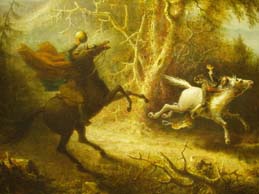
Recently, we deployed
our
company ghoul and likeable horror movie host Mr Creepo (aka "Mr UFO" -
Tim Beckley) along with sexy vamp hunter and Creepo henchwoman Circe
(or
is that wenchwoman?) to check out rumors of a revival of paranormal
activity in the dreamy village of Sleepy Hollow, New York, and
neighboring Tarrytown.
Though our budget was small, the researchers managed to drink and eat
-- mainly drink -- themselves into a tizzy as if possessed by
glutinous spirits. Very much, we fear, like the early farmers whose
wives accused them of "tarrying" to long on market day at the local
tavern, thus the name Tarrytown was born. In any respect we present
their -- pardon the expression - "sobering" -- report.
The cool autumn air sits in just before twilight and a breeze starts to
drift in from the Hudson River, just down the road a bit from where
legend has it Ichabod Crane was chased by the headless horseman.
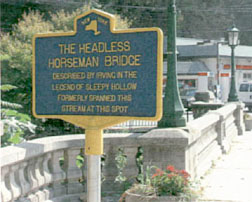
Indeed, the bridge and adjacent brook where Crane soiled his pants in
an attempt to run for his life still stands, albeit part of the main
drag that goes through town, a road now used by truckers, buses and
SUV's coming up from Manhattan a scant 40-minute drive away.
Many commuters unwilling to drive in the midst of quite ghostly (I mean
ghastly) traffic take to the rails, hopping onboard one of the numerous
commuter trains that make the trip from the Big Apple all day and well
into the evening hours.
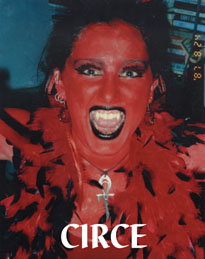
Folding back the pages of the New York Post
(we
are much to blue collar to read the Times) and
gazing out the window one would hardly guess that he area is
particularly rich in paranormal lore. But as you pass White Plains and
the office buildings start to diminish in height and number you can
start to be thankful that Circe is your traveling companion as ghouls
know well to leave her be. We figure it has to be the garlic in her
bag,
but she insists it is the lovely charms she makes and wears to
ward off negativity and things that go bump in the night.
But, indeed the truth sometimes can be very strange. For it is along
this very route to Sleepy Hollow back in 1982 that thousands craned
their necks out of car windows to watch as a silent, giant,
black-shaped
triangle filled the sky, much like the cloak of the headless horseman
is
said to have done as the phantom glided through the thickets and glades
of this same community in the early eighteen hundreds.
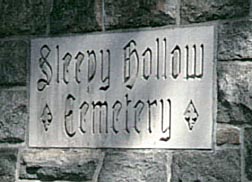
One of our first destinations was the Sleepy Hollow cemetery to visit
some of the communities founding members. Circe (made infamous for her
role of Muffy in my low budget vampire flix, The Curse of Ed Wood)
was perched on a tombstone while I frolicked with the angels near
the grave of Washington Irving.
Switching into a serious mode, I remarked how I could recall numerous
conversations with fellow researcher Philip Imbrogno whose book Night Siege: The Hudson
Valley UFO Sightings fairly well documents the numerous close
encounters in the area. I told Circe how Phil, a teacher by profession
(strange, wasn't Ichabod Crane also a teacher?) had started out as a
conservative investigator of unexplainable aerial phenomena only to end
up photographing ghost lights and confronting time distortions (to find
out more order my book Our Alien Planet: This
Eerie Earth in the
Conspiracy Journal bookstore). All within a few square rural miles of
where we were now standing.
During the course of our investigation in the area, we drove over into
Connecticut to hunt down giant Jack 'O' Lanterns known to be harassing
residents near an outdoor farmers market. This was pretty much the same
trek truck drivers had been on that fright filled night in 1982 when
they rubbed 18 wheelers with a "thing" the size of a 747 that tailed
them at less than a thousand feet in the air. Around the same
time
the mysterious men in black showed up to persuade witnesses to back off
from telling of their encounters with the unknown. Many similar tales
exist from the time of Washington Irving who also spoke of nightmarish
figures cloaked in black who staked those who dared discuss their own
paranormal misadventures.
Those who have followed such matters will be able to confirm that often
times places that have a reputation for being "haunted" have a long
history of paranormal phenomenon.
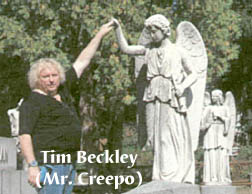
Indeed, it was Circe that reminded me that Washington Irving had,
himself, speculated on this very "coincidence" in his Legend of Sleepy Hollow
tale. To prove her point, she cracked opened a copy of Irving's book
just purchased at the Kyjuit gift shop on the Rockefeller Foundation
estate, scene of the annual Halloween activities that tourists flock to
this region along the Hudson every fall season.
To quote Irving: "A drowsy, dreamy influence seems to hang over the
land, and to pervade the very atmosphere. Some say that the place was
bewitched by a high German doctor during the early days of the
settlement; others, that an old Indian chief, the prophet or wizard of
his tribe, held his powwows there before the country was discovered by
Master Hendrick Hudson. Certain it is, the place still continues under
the sway of some witching power that holds a spell over the minds of
the
good people, causing them t walk in a continual reverie. They are given
to all kinds of marvelous beliefs, are subject to trances and visions,
an frequently see strange sights and hear music and voices in the air.
The whole neighborhood abounds with local tales, haunted spots, and
twilight superstitions; stars shoot and meteors glare oftener across
the
valley than in any other part of the country. . . "
One almost has to scratch their head in disbelief that this paragraph
was written two hundred -- give or take -- years ago. It seems like
something a contemporary ghost hunter like our pal Joshua Warren might
write in one of his scripts for the Discovery Channel.
As we hunkered down for the evening -- after hours of paranormal
musings -- we couldn't help but reflect on how the area seemingly
abounds in the macabre. In fact, all around us were signs and symbols
that a spooky October was in the works for the area just up the river
from our vampiric crypts.
THE
GREAT JACK 'O LANTERN BLAZE
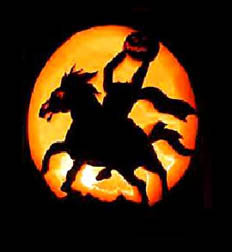
Three thousand hand carved pumpkins are the decidedly spooky backdrop
for a spine tingling event set on the grounds of the 18th Century Van
Courtland Manor. You might be a bit too scared to nip away at those
pumpkin cookies or sip down that warming cup of hot apple cider, as you
experience the SCARECROW AVALANCHE and PUMPKIN PROMENADE.
THE
HORSEMAN STILL RIDES!
Join Jonathan Kruk for a lively reading and reenactment of the Legend
of Sleepy Hollow at the Philipsburg Manor. For Legend Weekend (October
28-30) there will be candle lanterns and bonfires, and a haunted
landscape to set the mood. Say doesn't that fellow with the crooked
nose
over there look like??? Nah, it can't be!
Sponsored by the Historic Hudson Valley Society, more information can
be found at: www.hudsonvalley.org
or for ticket information call 9l4-631-8200.
WHERE
TO STAY
Numerous bed and breakfasts dot the scenic area. The Doubletree right
on the Hudson offers a breathtaking view, but we were stopped at the
entrance by the burly ghoul in charge who informed us before we
even had time to twist our heads around, that the palatial estate
was being renovated and thus closed to all. So I guess even the
Horseman
won't be staying there on Ole Hallows Eve.
If your budget is up to it and you are looking for really lavish
grounds, go ahead and plop yourself down on one of the beds at the
Tarrytown House. The restaurant wasn't open when we where there so we
had to venture out into the crisp autumn air. This slight incontinence
was offset by the use of the heated indoor pool (just call me Creepo
the
prune) and the fact looking out the window at around 3 AM I thought I
saw a specter under the flood lights in back of the complex where we
should have been fast asleep and not watching the Sci Fi Channel.
WHERE
TO EAT
For lunch there is the Horseman saloon and the Sleepy Hollow Cafe
(service is fine but if your seated outside you notice the sidewalk
slants more than it does in one of those mystery vortex spots).
For about the best meal ever in an absolutely superb setting stop by
Harvest-on-the Hudson in Hasting on the Hudson. Its right on the Hudson
(boy isn't that repetitive) and outdoor dinning for lunch will be a
treat you won't forget for a long time. Lots of indoor seating as well,
and a bar that goes on for miles (thank you, but we had our
Bloody
Mary's on the lawn).
Thus ended our little adventure...Being psycho -- I mean psychic -- I
asked Circe about the vibes. She didn't appear to be scared out of her
wits despite the traffic headed home, so I guess the spirits weren't as
restless as they might have been.
So do we plan to return to Sleepy Hollow and Tarrytown to search for
more spirits? It could well be that sometime in the not to
distant
future we might set up shop to film our own version of Sleepy Hollow --
except it will called CREEPY
HOLLOW.
Happy
Halloween from Mr Creepo, Circe, and the staff of the Conspiracy Journal
and www.MrCreepo.com
-
STRANGE CREATURES FROM TIME AND SPACE DEPARTMENT -
Night Crawlers - Reality of
the North American Ape
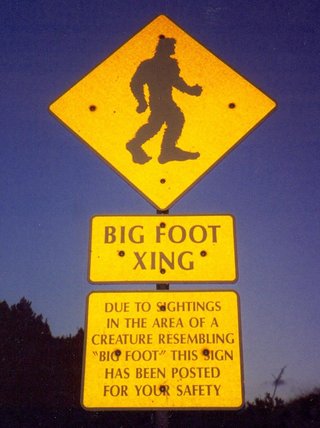
Huddled by the campfire, the screech of a creature unknown raises the
mother of all goose bumps. Was it Bigfoot or Mothman, the Chenoo or
Chupacabra?
Tales of these legendary forest creatures are not for folks who sleep
with the lights on, peer under beds and inspect closets before bedtime.
The rest of us relish a morsel of fright and a quality shudder.
Did you hear the one about Old Mossback or the superhuman Lemurians who
inhabit an underground city of gold beneath Mount Shasta? Long sacred
to American Indians, Mount Shasta also is believed to be the site of
magic crystals, UFO landings and, gasp, the doorway to another
dimension.
Lakes are said to be inhabited by serpentine creatures like Tahoe
Tessie (Lake Tahoe) and Ogopogo (Lake Okanagan, British Columbia). And
we'd be neglectful not to mention the outdoors-loving werewolf and the
American Indians' Wendigo. Both are meat eaters.
Not that such things deserve credence, but do watch for exposed tree
roots while sprinting for the car.
Chills in the West mostly are courtesy of Bigfoot, sometimes called
Sasquatch. Thought to be a stinky, hairy, bipedal humanoid, Bigfoot
mostly has been reported roaming from California's North Coast on up
into Canada.
Reports of face-to-face encounters, awful odors, unearthly screams and
humongous footprints are logged and investigated by people with degrees
in science. And just try to convince the backpackers, the campers and
the fishermen who have seen Bigfoot that it doesn't exist.
"I saw one when I was 4 years old, and I've since talked to about 200
who have seen one," says Michael Rugg, proprietor of the Bigfoot
Discovery Museum in Felton, near Santa Cruz. "You see one of these
things yourself and it takes away your skepticism."
Nonbelievers laugh themselves silly over such claims. Hazel Gendron,
who lived in Happy Camp for many years, scoffs at the existence of
Bigfoot. Happy Camp, 323 miles north of Sacramento and near the Oregon
border, is Bigfoot country. Its backyard is the Siskiyou Wilderness
area, a vast, forested region described as the most isolated and remote
wilderness area in the United States.
"Not a believer," says Gendron, now living in Shasta Lake City. "I
always backpacked in those mountains without a gun, sometimes camping
eight or 10 days at a time. I never carried a gun, only a camera. It's
not the animals I was afraid of, it was the marijuana growers out
there."
Gendron, a historian and author, believes the Bigfoot story may have
originated from the Tolawa tribe.
"The old Indians had ancient stories handed down which had moral themes
and also themes to keep the kids in line," she says. "If the kids
happened to wander off, this big, hairy man was going to get them. That
was probably the beginning for the idea of Bigfoot."
Vinson Brown: 'Believe it'
Fear can be inspired by things living and allegedly living, things seen
and unseen.
"The great majority of Bigfoot sightings are associated with extreme
fear," Rugg says.
Maybe it was a shadowy figure, the snap of dry twigs, the rustling of
brush that froze the soul of Vinson Brown. Something was out there,
shrouded by the inky blackness of the Siskiyou Wilderness area. Brown
and his German shepherd could feel its presence.
"The hair on the dog was standing straight up, and that dog wasn't
afraid of anything," says Barbara Brown, relating her late husband's
story. "He (the dog) even scared off bears."
Whatever was out there behind their home in Happy Camp that night made
a believer of Vinson Brown.
"He didn't believe in Bigfoot, but he did after that night," she says.
Sightings or reports have been made in every state but Hawaii,
according to the Bigfoot Field Researchers Organization (www.bfro.net).
Washington leads with 414 incidents, followed by California (369) and
Oregon (199).
More fascinated than scared
A BFRO investigator interviewed a backpacker two years ago after a
Bigfoot encounter in the Desolation Wilderness area of El Dorado
County. In part, the unnamed backpacker had this to say: "My tent is
about 4 feet tall, maybe a little less, and what I saw was more than
twice as tall. At first I couldn't see any features, just the outline.
Then it took a couple of steps towards me. I almost peed my pants right
there. I picked up the .45 and took a shot off to the left of it. It
stopped and looked at me. Then it started walking towards me again. ..."
Cryptozoologists, scientists who actually investigate the possible
existence of undiscovered animals, have one point in their favor –
nobody has ever disproved the existence of Bigfoot.
Rugg's encounter with Bigfoot came during a family fishing trip to the
Eel River in Humboldt County. He says he felt more fascination than
terror and that the encounter began a lifelong hobby of collecting
Bigfoot items. His Bigfoot Discovery Museum is a shrine to all things
Bigfoot.
"Deputy sheriffs, forest rangers have seen them, even a few Ph.D.s on
vacation," Rugg claims. "Smart people who aren't likely to mistake it
for a bear or the rear end of a moose. It's pretty hard to continue
being a skeptic."
Admitted Bigfoot hoaxes are discredited by Rugg, who claims those who
suit up in a costume or "find" footprints are motivated by publicity.
"You could disprove some of the evidence, but you cannot disprove
Bigfoot," he says.
Just a month ago, Rugg says, Bigfoot was sighted in the Santa Cruz
area. He added that the sightings "usually start in August," when fruit
begins to ripen on trees, and continue well into October. Bigfoot is a
big fan of fruit, but then so are bears.
On plums and pots
Barbara Brown, whose late husband became a believer in Bigfoot,
actually sleeps outdoors in the fall to discourage bears from eating
and damaging her fruit trees. Her home backs up to the Siskiyou
Wilderness area, but she's not concerned about Bigfoot.
"The dog barks, I get a flashlight and bang on a pot," she says. "Brown
bears like plums and are a nuisance. They'll break off branches to get
to the fruit."
Many wouldn't sleep out near Happy Camp for all the fruit in the world.
Source: The Sacramento Bee
http://www.sacbee.com/107/story/452219.html
- I LIKE THOSE OLD-TIME ROCK & ROLL
GHOST STORIES DEPARTMENT -
Rock-Star Ghost Diaries
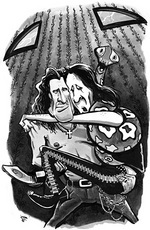
These ghoulish tales will make
you wet your pants with fear!
Most ghost stories are pretty damn lame, and most happen to everybody
except musicians. If you attempt to seek out ghost stories from pop
stars, you quickly discover that phantoms, freaky psychic phenomena,
and even UFOs aren't nearly as numerous as popular culture has us
believe. In fact, one might estimate that maybe one in five musicians
has something to say on the subject, and when they do, odds are it's
just about as exciting as the story your neighbor Hal tells about his
mother-in-law's first cousin seeing her dead uncle take a bath in the
family cottage.
But hey, Halloween is here again. After several months asking rock
stars questions like "Have you ever had an encounter with the
supernatural? No, not the lame television show!," we've collected some
stories that might scare a toddler, and others that are almost as scary
as a Stephen King novel. And like any good horror movie, they get more
thrilling as you go along, so get out the garlic and spare proton pack,
and brace yourself for the rock-star ghost diaries.
James Valentine, Maroon 5: "[We recorded our latest, It Won't Be Soon
Before Long, in Rick Rubin's allegedly haunted house]. One night, I saw
a figure walking up the stairs, when there was nobody else in the house
except my girlfriend at the time. I was so certain that I'd seen
someone that I called out to this thing and then went up to the room
that it had walked into. There was nobody there. I don't know how to
explain it, but that's what I saw. I got the impression it was a woman,
and apparently other people had talked about a female spirit that they
had seen."
Steve Bays, Hot Hot Heat: "I used to always play drums in bands. I grew
up on an island, and there were never many good drummers. I always
wanted to switch up and play different instruments, though. I met a guy
who could play drums — and hard-hitting drums. At the time, I basically
wanted to play metal or at least heavy music. [So] we formed this band
together, and on the night of our first jam, we drove forever out to
his place — this really forested area. He hadn't drummed in a year,
because, he said, he'd been drinking and into drugs for that year. But
he said, 'I've quit now.' So I played guitar. He played drums. But I
remember he was sweating a lot through the whole damn thing. Rehearsal
was great. I go home, and that night I have this really crazy dream,
where I go into the bathroom and see this guy in the mirror. He's
basically saying goodbye to me. This ghostly figure in the mirror is
saying goodbye to me, and he gives me this necklace — this medallion. I
didn't make anything of it, but I clearly remembered him saying goodbye
to me through the mirror. The next day, I heard three hours after the
jam, he died. His heart stopped. I guess his body was so run down that
drumming for three hours essentially killed him. It's creepy. When he
died was basically when I had the dream."
Alice Cooper: "I get out of rehab [in 1983], and [Aerosmith guitarist]
Joe Perry got out of rehab at the same time. I was going to write two
songs for this movie I was going to be in and thought, 'I'll call Joe,
and we'll do this together.' My manager set up this house in upper New
York. Joe's assistant went up there. My assistant went up there. We
checked into this big old house in the middle of farm country — this
big gothic-looking thing. I'm putting my clothes away. I leave the room
and come back, and the closet door is closed. The drawer I was packing
is closed. Hmm, I don't remember closing that. This house was so full
of whatever that on the second night we're there, we're sitting there
eating dinner, and it sounds like somebody is moving furniture in the
basement. It's making so much noise. It's not even trying to be subtle.
I say to Joe, 'We're the only ones here, right?' I'm not going down
into the basement to find out what's down there. I say, 'This house —
every time I put my coat down, I come back and it's gone.' Joe says,
'The same exact thing is happening to me too. I thought I was just
going through a recovery thing — being forgetful.' I say, 'No, this
place is insane.' So we ran out of the place. I found out later this is
where the guy who wrote The Amityville Horror wrote the story — there
in that house."
Source: Cleveland Scene
http://www.clevescene.com/2007-10-24/music/rock-star-ghost-diaries
-
SPACESHIP OF DREAMS DEPARTMENT -
David Hamel Was Building
Spaceship to Fly to Planet Kladen
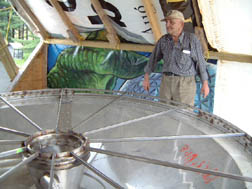
GILMOUR -- It was only just recently that word got out that David Hamel
had died, or that his care worker had at least stumbled upon the mortal
body of the man who, after being abducted by aliens, proceeded to build
his own spaceship here in the large Quonset hut behind his old
farmhouse.
If he has since been spirited away by his extraterrestrial friends from
the planet Kladen, 4 billion km away on the other side of the sun, his
nearby gravesite would appear to be undisturbed.
So there is no way of knowing.
Travel back two years in time to the land of the living, however, and
Dave Hamel is found working away in that hut. He looks like a
grey-skinned gremlin, and he has little patience for disbelievers. In
fact, he is quite profane when a dumb question is asked, such as, "What
will propel your spaceship?"
"F---ing energy," he yells, frustrated by the questioner's obvious
ignorance concerning the science that was provided to him, through
telepathy, by the silver-suited aliens who abducted him 29 years
previously when he was working as a carpenter in British Columbia.
And then he goes on to talk, at great length, about magnets and granite
spheres, and vibration working hand-in-hand not only to propel his
stainless-steel craft but to also make it "weightless."
"Do you understand now?" he asks me, tugging at his greasy ball cap and
rolling his eyes. "Or are you just stupid?"
VASTNESS OF CYBERSPACE
The tour takes more than an hour. Behind his house, in that locked hut,
is the epicentre of his craft -- indescribable to those who lack
Hamel's alien-gifted technological savvy, although there are scores of
true believers who, in the vastness of cyberspace, have created
websites dedicated to promoting the brilliance of his "Hamel
Technology," and have even written books on his experiences and his
efforts to build his spacecraft.
All one has to do is "google" his name.
Out back of Hamel's house on this August day three years ago, past a
sign of warning, the craft's wings can be found, octagonal steel
structures that appear akin to science fiction's depiction of flying
saucers.
After almost three decades of work, however, it would appear as if the
craft is years away from completion.
"It will be done when it is done," says Hamel. "So what if I'm 80?
Maybe I'll be 180. It doesn't matter. The survival of the human race is
at stake. That's what this is all about. It's about the survival of our
species."
Hamel says the aliens who abducted him flew him to this place off
Weslemkoon Lake, some 50 km north of Madoc, and told him to build his
spaceship in this very spot.
Inside Hamel's home, his infirm wife, Nora, who died a few weeks later,
sits in a wheelchair and says nothing as her husband points to the
blueprints he drew of his project, and if there is a genius in this
far-out scenario, it is in these detailed drawings.
They look totally unfathomable and therefore totally plausible.
"(The aliens) planted these drawings in my brain," he says. "They gave
me all the instructions I needed."
He says to envision a butterfly floating above a magnetic field,
weightlessly and effortlessly.
"It is now up to me to make it work. The end of the world is not far
off, and we need some of us to survive. Otherwise, all is lost."
And perhaps it now is.
Fast forward to this October day, 2007, and the Quonset hut is locked.
The windows of Dave Hamel's home are boarded up. A disabled old truck
sits in the driveway.
David Hamel was 83 when his body gave out. Born in Rosemont, he was one
of 13 siblings. He fought in World War II, and enlisted again for Korea.
After his last war, he headed for the lower Fraser Valley in B.C., met
his future wife Nora, already stricken with cerebral palsy, her legs in
braces.
Hamel was working as a carpenter, and life seemed normal.
And then, on Oct. 21, 1975 -- 32 years ago this Sunday -- Dave Hamel
was sitting his armchair, watching The Waltons, when his television
suddenly goes snowy.
It was the moment his life changed.
In a book on his life called The Granite Man and the Butterfly, written
by Jeanne Manning, three visitors from the planet Kladen -- one
human-looking woman and two human-looking men -- entered his presence,
and lifted him up to their spaceship where they implanted their
technology into his brain, telling him he would be the instrument
entrusted with the survival of his species.
The woman's name was A. Arkan was her husband, and On was the mechanic.
They spoke to him through telepathy.
IN B.C. NEWSPAPER
Until a waitress in a coffee shop snitched on him to a local B.C.
newspaper, Hamel was making plans to follow the aliens' instructions in
obscurity. And then came the headline, "Introducing David Hamel -- He
Rides In Flying Saucers."
The reporter wrote that Hamel knew the secret to perpetual motion, and
was building a device to allow people to heat homes, power industry and
fly aircraft without the use of fossil fuels. He added that, according
to local health authorities, there were no records to cast doubt on
Hamel's sanity.
And that is how it began.
It ended here, in this tiny village where a spacecraft from the planet
Kladen came 32 years ago this Sunday, and three aliens pointed to an
old farmhouse below and told David Hamel to build his own space ship in
the very spot where a locked Quonset now stands, and where all the
windows are now boarded up.
Down the road, at the Gilmour Cemetery, the engraver has yet to arrive
to inscribe the date of Hamel's death on the granite tombstone he
shares with his wife.
Perhaps the engraver is awaiting proof that he is actually gone.
Just in case the approaching Sunday brings visitors from beyond.
Source: Canoe
http://cnews.canoe.ca/CNEWS/WeirdNews/2007/10/19/4589260-sun.html
-
FEED ME SEYMOUR DEPARTMENT -
India's Cow Eating Trees
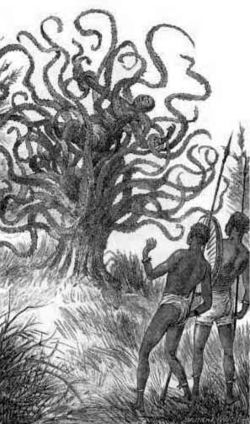
In Roy Mackal’s book, Searching for
Hidden Animals (NY: Doubleday, 1980), his last chapter is
entitled “The Monstrous Plants.” It was not about cryptozoology,
needless to say, but about cryptobotany, being a short treatise on the
Victorian accounts of man-eating plants.
As Mackal points out, many zoologists and botanists have been
fascinated by plants that eat meat since the days when Charles Darwin
was bitten by this interest, and wrote a definitive work on the
subject, Insectivorous Plants, published in 1888.
Like Mackal, who tells of having acquired several varieties of
carnivorous plants after reading about them in Darwin, I recall as a
boy buying and successfully raising Venus flytraps (Dionaena
muscipula), after reading about the plants in Willy Ley’s Salamanders
and Other Wonders (NY: Viking, 1955).
Recently, I’ve actually thought about getting some more, to raise them
in this bay window here at the museum. The plants still intrigue me.
Nature does have some fine wonders.
Anyway, Mackal spends his final chapter detailing mostly the reports
from the 1850s through the 1940s of the “Man-Eating Tree of Madagacar,”
and the expeditions that searched (unsuccessfully) for the species.
Little did I imagine that I would run across a new story of a similar
nature, but here it is, from today, from South India: “Cow-eating trees
of Padrame.”
Mangalore: Carnivorous trees grabbing humans and cattle and gobbling
them up is not just village folklore.
Residents of Padrame near Kokkoda in Uppinangady forest range sighted
one such carnivorous tree trying to dine on a cow last Thursday
[October 18, 2007]. According to reports, the cow owned by Anand Gowda
had been left to graze in the forests.
The cow was suddenly grabbed by the branches and pulled from the
ground. The terrified cowherd ran to the village, and got Gowda and a
band of villagers to the carnivorous tree.
Before the tree could have its meal, Anand Gowda and the villagers
struck mortal blows to the branches that turned limp and the cow was
rescued. Uppinangady range forest officer (RFO) Subramanya Rao said the
tree was described as ‘pili mara’ (tiger tree) in native lingo.
He had received many complaints about cattle returning home in the
evenings without tails. On Friday, the field staff confirmed coming
across a similar tree in Padrane, partially felled down.
However no detailed inquiry was made as the authorities were not asked
for any report, Rao said.‘Cow-eating’ trees of Padrame, Tuesday,
October 23, 2007, Express News Service, New IndPress.
Source: Cryptomundo
http://www.cryptomundo.com/cryptozoo-news/treeseatcows/
SUPPRESSED SCIENCE - FREE ENERGY
- ANTIGRAVITY
Tesla's Secret Lab -
www.teslasecretlab.com
Articles - Information - Amazing Books and Products - Including
Tesla Purple Energy Plates!
All Tesla - All The Time At Tesla's Secret Lab - Drop by for a
visit Today! - http://www.teslasecretlab.com
|
















